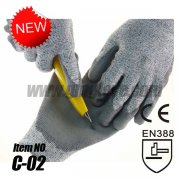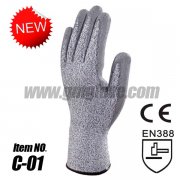Cut Resistant Gloves
-

Dyneema Cut Resistant Work Gloves Level 5 | Cut Resistant Gloves level 5
-

Dyneema Cut Resistant Gloves,PU Coated,Level 3
Total 1 Pages 4 Items
A lot of people work at tasks that expose them to the risk of cuts, calling for them to protect their hands while at it. Cut resistant gloves are examples of protective gear for people who work in welding, drilling, assembly and casting among other jobs that expose them to sharp objects that could cut. For top tier performance, the chosen glove should have perfect balance besides protection against sharp objects and provision of grip and hand dexterity. Durability and comfort are other factors that make the best cut proof gloves. Here are more qualities of a good cut resistant glove;
Performance
Protection performance depends on several factors including the materials, fabric construction, coatings and weight. The latter also known as basis weight in glove terms refers to its weight per area of fabric unit. The higher the basis unit the better as it increases a gloves resistance to cuts owing to more materials. It is wise noting that basis weight doesn’t affect overall weight.
The type of material also affects glove performance. Kevlar and blends of synthetic yarn as well as fiberglass are the most high performance cut resistant glove materials and therefore a popular choice. In addition to the material cut resistance is also dictated by the threads, stitches per inch and knit type among others.
Most cut resistant gloves are usually coated with other materials that enhance its performance. Different companies use different coating materials with varied thickness which has a direct impact on their effectiveness. This is in line with physics principles that a thick coating may provide more resistance than the opposite.
All these factors determine a gloves performance and if one is compromised, its quality goes down a notch. This is why customers must consider all of them when out shopping for cut proof gloves.
Suitability
Besides performance, you must assess a glove’s suitability to intended purposes. Gloves made from one material may be perfect for a certain application and totally wrong for another. Some materials for example are made from materials that are not acceptable in food handling but are ideal for workshops. Cut resistance is heightened by a metal mesh formed by interlocking stainless steel threads. Top notch abrasion, punctures and cuts resistance comes from steel’s strength. The metal used in this case is safe for used in meat processing applications as well as glass, automobile, paper and metal fabrication industries to mention but a few.
Some cut resistant gloves which are made with flexible metal fiber are ideal for the rubber industry, metal fabrication as well as plastic manufacturing. Spectra Fiber gloves are actually made from polyethylene fiber which is high in molecular weight. This results in gloves stronger than steel fiber gloves and very efficient in wet conditions.
Kevlar fiber glove brands are more popular, thanks to high resistance to heat and cuts. They are very light weight and flexible which is perfect for glass handling and automobile industries. Blended fibers make work gloves only stronger with superior grip and flexibility.
A good cut resistant glove should not hinder flexibility as you transition from one task to another. Despite their importance, gloves are not advisable when working on machines with moving parts as they could cause accidents.
Measurements
All cut resistant gloves manufacturers or suppliers must comply with American National Standards Institute as well as International Safety Equipment Association not to mention the norm 388 European standard.


